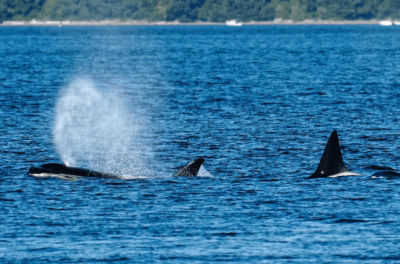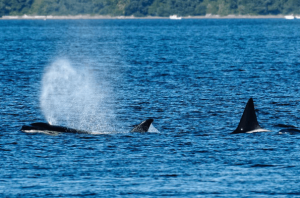
Here at CIMI our backyard is full of all kinds of marine animals. The biggest of these animals includes the many species of cetaceans (whales, dolphins, and porpoises), which pass through the channel between Catalina Island and California quite frequently. As large as these animals are, chances are that you will be viewing them from a distance whether it’s on land or on a boat. Most of the time the only thing you will get to see from these magnificent creatures are there whale spouts, flukes (tail fins), or their backs whenever they surface and dive.
 When whales spout, you will see a geyser of water shoot up into the air that can be seen from miles away. This water that is shooting out however is not seawater but it is the condensation of the warm insulated air that is being shot out of the whales lungs mixing with the comparatively cold air from outside. Every species of whale has a distinctive kind of shape of their blowholes and also has different sized lungs therefore each type of spout shape and size. Each species of whales also will have different shaped flukes and ridges of their backs. The whales that frequently go through our channel include some larger baleen whales such as the grey whale, blue whale, fin whale, and humpback. Baleen Whales have two blowholes whereas toothed whales like dolphins and porpoises only have one single blowhole.
When whales spout, you will see a geyser of water shoot up into the air that can be seen from miles away. This water that is shooting out however is not seawater but it is the condensation of the warm insulated air that is being shot out of the whales lungs mixing with the comparatively cold air from outside. Every species of whale has a distinctive kind of shape of their blowholes and also has different sized lungs therefore each type of spout shape and size. Each species of whales also will have different shaped flukes and ridges of their backs. The whales that frequently go through our channel include some larger baleen whales such as the grey whale, blue whale, fin whale, and humpback. Baleen Whales have two blowholes whereas toothed whales like dolphins and porpoises only have one single blowhole.
The grey whale can have two very widely dispersed spouts in a “v” formation and can be between 9 and 16 feet in the air. They lack a dorsal fin but have several knuckle like ridges on its back that show as it surfaces or dives down. Their flukes are convex and usually ragged with a distinctive deep notch in the middle making the shape of a “whale” groomed mustache. They may pass through the Catalina Channel coming from the arctic on their way to forage for food in Southern California and Mexico.
 Blue whales have been in the channel migrating to tropical waters in order to give birth to breed and give birth to their young. Their flukes are much less robust than the grey whales fluke with much more straight trailing edge and a shallow notch in the middle. Their spouts can be up to almost 40ft high and look like a slender column of spray that looks like the green stalk of a carrot. Blue whales have a small triangular and variably curved fin dorsal fin sitting towards its caudal region and have a smooth back.
Blue whales have been in the channel migrating to tropical waters in order to give birth to breed and give birth to their young. Their flukes are much less robust than the grey whales fluke with much more straight trailing edge and a shallow notch in the middle. Their spouts can be up to almost 40ft high and look like a slender column of spray that looks like the green stalk of a carrot. Blue whales have a small triangular and variably curved fin dorsal fin sitting towards its caudal region and have a smooth back.

Fin whale are very similar in appearance to the blues where they have a slightly more robust and curved dorsal fin and fluke and can be seen year round near the sea of Cortez.
Humpbacks have a rugged looking fluke with robust curves and many ridges through out the fluke as well as a deep v shaped notch in the middle of the fluke. They have a low stubby dorsal fine with a broad based followed by slight ridges going down its back towards the fluke. Their spouts can be up to 9 feet high and can be heart shaped. They can typically be found in higher latitudes during the summer to feed in colder water and in the winter will head to warm watered breeding grounds.
The most common toothed whales that come through Catalina Island include the Rissos, common, and bottlenose dolphin and on a rare occasion even an Orca or killer whale. Orcas can be found on the Pacific coast especially in Washington but will sometimes follow food all the way down to Southern California. They have a very distinctive black and white pattern on their tails and have a very widely dispersed spout.

So just based on their fins, spouts, and flukes you can be an expert in recognizing these magnificent animals. Next time youʼre out on the ocean be sure to bring a pair of binoculars to see if you recognize any whales from a distance!
Sources:
http://www.oceanlight.com/stock-photo/blue-whale-surfacing-picture-09497-518553.jpg
http://archives.evergreen.edu/alumni_writers/Calambokidis/WhaleSpout.jpg
https://i.pinimg.com/originals/fc/0f/2a/fc0f2abe2d88afeeaefbd0bdf28aa635.jpg
http://2ap93t1x1l6e2f6gfo3ag4vw.wpengine.netdna-cdn.com/wp-content/ uploads/2017/11/f0k5103-2-1000×480.jpg
http://www.north-atlantic-society.com/_Media/75987_441852565862752_91248_med.jpeg
https://voicefortheblue.files.wordpress.com/2017/07/ fin_whale_hero_and_circle_image_107654.jpg
https://www.whalestaildepoebay.com/wp-content/uploads/2016/11/
page_photo2_5B1D2673-371C-4C42-B2A7-9D1F5D604403.jpg
https://dumielauxepices.net/sites/default/files/tail-clipart-whale-fluke-790764-9645110.jpg
http://wildwhales.org/wp-content/uploads/2017/06/greydorsal_popup.jpg
http://www.marinemammalcenter.org/assets/images/education/folkens/gray-whale-732×334.jpg
https://i.pinimg.com/originals/8a/ f0/92/8af09277f26585a428ae9d2fa9a8f64a.jpg
https://c1.staticflickr.com/5/4291/36112710621_f6056fcd30_b.jpg
https://cdn-images-1.medium.com/max/2000/1*kae3mQ7ExsE2GyjO3vfHig.jpeg
Whales Dolphins And Porpoises by Mark Carwardine 1995, 2002


